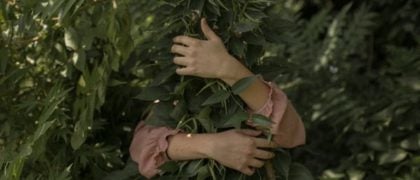THE HEADWATERS
Our pilot, David Kunkel, asked me to retrieve his oxygen bottle from under my seat, and when I handed it to him he gripped the plastic breathing tube with his teeth and opened the valve. We had taken off from Boulder not long before and were flying over Rocky Mountain National Park, thirty miles to the northwest. Kunkel was navigating with the help of an iPad Mini, which was resting on his legs. “People don’t usually think altitude is affecting them,” he said. “But if you ask them to count backward from a hundred by sevens they have trouble.” What struck me at that moment was not how high we were but how low: a little earlier, we had flown within what seemed like hailing distance of the sheer east face of Longs Peak, and now, as Kunkel banked steeply to the right to give us a better view of a stream at the bottom of a narrow valley, his wing tip appeared to pass just feet from the jagged declivity beneath us. Snow had fallen in the mountains during the night, and I half expected it to swirl up in our wake.
The other passenger, sitting in the copilot’s seat and leaning out the window with a big camera, was Jennifer Pitt, who at the time was a senior researcher for the Environmental Defense Fund. Pitt is in her forties. She has long brown hair, which she had pulled back into a ponytail,and she was wearing a purple fleece. She worked at the EDF, mostly on issues related to the Colorado River, from 1999 till 2015, when she moved to a similar job at the National Audubon Society. In recent years, her focus has been on the river’s other end, in Mexico, but she had agreed to show me its source. Our principal destination that day was the Colorado’s headwaters, just over the Continental Divide, roughly fifty miles south of the Wyoming state line. “The best way to see a river system is from the air,” she’d told me earlier. She arranged our flight through LightHawk, an international nonprofit organization that supplies volunteer pilots and their airplanes, at no charge, for a varietyof environmental purposes. The previous day, a LightHawk pilot had flown twenty black-footed ferrets from Fort Collins to a spot nearthe Grand Canyon, for relocation.
Before our flight, I looked up Kunkel on Google and was disconcerted to find a news story about him landing his Cessna 340 on a highway high in the Rockies after losing both engines in succession. But then I realized that nothing like that could happen to us, because the plane he’d be using for our trip, a Maule M-7, had just one engine. I looked up Pitt, too. She was born in Boston and grew up in Westchester County, New York, in a suburb of New York City. “I think you can trace my interest in rivers back to my childhood in Westchester,” she told me later, “because I grew up in a river town, on the Hudson, and when I was a kid Pete Seeger came to my school and sang to me about rivers.” As an undergraduate, at Harvard, she majored in American history and literature, but developed an interest in urban planning and landscape architecture. “After graduation,” she continued, “I worked in Manhattan for a year, for the Department of Parks and Recreation, and realized that that was not what I wanted to do.” She got a job as an interpretive ranger in Mesa Verde National Park, in southwestern Colorado,and that experience, she said, “gave another twist to my view of the world, and how an ancient culture used the resources around them.” She earned a master’s degree in environmental sciences, with a focus on water, at the Yale School of Forestry, then worked in Washington, D.C., for five years, mostly at the National Park Service. In 1999, the Environmental Defense Fund hired her to create programs related to the Colorado River and the ecosystems that depend on it. In 2003, she married Michael Cohen, a senior associate at the Pacific Institute, another environmental organization. (They met at a water conference in Tucson.) They live in Boulder and have a daughter.
Kunkel dipped a wing, and Pitt pointed toward the Never Summer Mountains, on our right. “There’s the Grand Ditch,” she said. I saw what looked like a road or a hiking trail cut across the face of a steeply sloping forest of snow-dusted conifers; she explained that it was an aqueduct, dating to 1890. Its original full name was the North Grand River Ditch. (Until 1921, the section of the Colorado that’s upstream from its confluence with the Green, in eastern Utah, was called the Grand. Hence: Grand Lake, Grand Junction, Grand Valley—but not Grand Canyon, which was named for its grandness.) It was built with pickaxes and black powder, mostly by Japanese laborers, and it operates by gravity—an impressive feat of pre-laser engineering. The Grand Ditch is fourteen miles long, and much of it is above ten thousand feet. It carries water across the Continental Divide at La Poudre Pass and empties it into a stream that flows toward the state’s eastern plains, where even by the late 1800s farmers were feeling parched. It doesn’t tap the Colorado directly, but captures as much as forty percent of the flow from slopes that would otherwise feed it, like a sap-gathering gash in the trunk of a rubber tree. We had already flown over several larger, more recent additions to the same network: Long Draw Reservoir, completed in 1930; Estes Lake, which serves as a trans-basin junction box; and five connected natural and man-made lakes that lie on the western side of the divide and gather and store water from the Colorado or its watershed. The northernmost of the lakes spills as much as a third of a billion gallons a day into the Alva B. Adams Tunnel, which was built in the 1940s. Adams was a lawyer and a U.S. senator, and in the early 1930s he served as the chairman of the Committee on Irrigationand Reclamation. The tunnel moves the water under the center of the park, drops it through five hydroelectric generating plants, and delivers it to a distribution system that serves a populous area east of the mountains, including Boulder. The main elements of the system are known collectively as the Colorado-Big Thompson Project. (In the West, “project” almost always means “dam,” “reservoir,” “aqueduct,” “canal,” or all four).
Kunkel made a slow turn to the left. “We just flew over the headwaters,” he said. Our position was easier to see on his iPad than on the ground. The sky had been blue when we took off, but since we’d entered the mountains he’d had to pick his way under and around what sometimes looked like an upside-down ocean of clouds. The ceiling made flying difficult but helped to explain the existence of the water-storing-and-shifting network we’d been looking at. As moisture-laden weather systems move eastward across the western United States, they pile up over the Rockies, dumping snow and rain. Eighty percent of Colorado’s precipitation falls on the western half of the state, yet eighty-five percent of the population lives to the east, in the mountains’ “rainshadow.” If transporting water from one side to the other were impossible, most of the people who live and farm on the eastern side of the mountains would have to move. Pitt said, “Even people who describe themselves as worried environmentalists usually have no idea where their water comes from. We did a focus group once where somebody asserted vehemently that Denver did not get any water from the other side of the mountains, and we actually had to intervene and make sure that the guy leading the focus group knew that that was wrong, so that the whole two-hour discussion didn’t go off in some other direction.”
Copyright © 2018 by David Owen. All rights reserved. No part of this excerpt may be reproduced or reprinted without permission in writing from the publisher.









